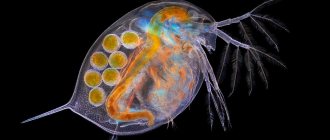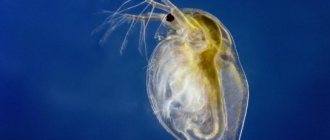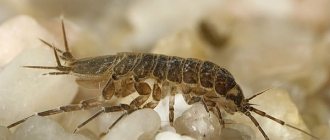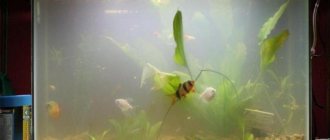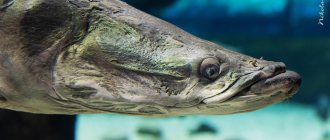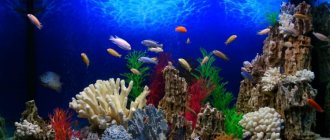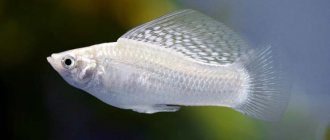Artemia are branchial crustaceans that are used as food for medium-sized aquarium fish, including bottom fish. The good thing about crustaceans is that they are suitable for breeding at home. Artemia are quite unpretentious, therefore, having bought their larvae (nauplii) in the store, you can grow fish food at home and cross this item off the cost list.
Artemia is a micro crustacean used as fish food.
Description and features
Daphnia grow 2-5 mm in height and have fairly rounded bodies. Daphnia under a microscope: at the top is the head, clearly visible in most species under a magnifying glass, with a large, dark-colored compound eye and a much smaller eye. Water fleas are colored from reddish to light brown transparent.
Daphnia photo: to the right and left of the head, the legs stick out like oars, with the help of which it moves. At the end of the body there is a process. Females are light in color (summer eggs) or dark in color (winter eggs).
The water flea moves through the water in jerks, “jumping.” They usually swim in water; you will almost never see them sitting on substrate.
Where does Daphnia live?
A genus of Daphnia that lives in stagnant or slowly flowing fresh waters, and quite rarely they can even live in the sea. Water fleas in an aquarium for invertebrates (shrimp) are absolutely problem-free. In man-made pools they can be used to purify the water; in filtered pools they starve because it costs them too much energy to fight the current with their rowing legs. Shrimp love to eat dead water fleas and will sometimes even grab a living animal.
Life cycle
During the life of daphnia, there are a number of stages accompanied by molting: the first three are juvenile after 2, 24, 36 hours; fourth – egg maturation; fifth – laying eggs at intervals of 2-3 days; sixth - eggs are not laid. Daphnia lives from 26 to 47 days.
Natural enemies
Daphnia crustaceans use chemicals to detect whether their predators, the tufted mosquito larvae, are hunting nearby. In the presence of plastic, small aquatic life may be poorly equipped against predators. While eating, the predator releases substances into the water, which then signal to the prey that it is there. And then the victim will be able to protect itself from the predator. But water fleas are less able to protect themselves from predators if there is plastic in the water.
Benefits and harms for the aquarium
Daphnia in the aquarium is not as common as you might think. In ecotoxicology, the daphnia test is a popular tool for detecting contaminants in water. Notable species include, for example, Daphnia magna, the large water flea, Daphnia pulex, the common water flea, Moina macrocopa, the Japanese water flea.
With small living creatures you get information about the water quality of a reservoir. They are very sensitive to pollutants: if the water is polluted, "water fleas" exhibit unusual swimming behavior, no longer reproduce and die.
Value as fish food
Daphnia are a popular fish food that is highly prized for its chitinous, high-fiber shell. Since you can not only buy water fleas as live food from a pet store, but also breed them as live food, they are very well known in the aquarium hobby.
Danger to humans
Water fleas and the human immune system have one thing in common: only when there is a real threat from an attacker do they develop certain defense mechanisms. In the human body, antibodies and immune cells take over the defense; in the case of water fleas, even the entire body changes.
Important! Daphnia cannot bite humans, and they are not related to the human or animal fleas you deal with at daycare or on pets. Therefore, the term "water fleas" is actually a misnomer. It probably comes from a jumping swimming motion.
Gammarus mining
Dried or frozen amphipods are easy to find in a pet store; live amphipods are sold at the poultry market. You can catch them yourself; this is not a difficult task, but it is painstaking. Gammarus are caught in several ways:
- Using hay or straw. First you need to build a trap. A frame (square or round) is made from wire, and the mesh is attached to its edges. For convenience, you need to tie the ropes. The finished frame is covered with tufts of grass and released into the pond. Gammarus will fill all the voids quite quickly. After some time, the device is pulled out of the reservoir and shaken into a bucket of crustaceans.
- Using burlap. A piece of burlap (necessarily natural) is tied to a long stick and passed along the bottom of the reservoir; the disturbed crustaceans grab onto the fabric. You will have to collect amphipods from the fabric manually.
- With the help of a net. This method is only suitable for reservoirs with a large population of crustaceans. The mesh in the net should be fine.
If you plan to keep caught amphipods in an aquarium in the future, you should collect water and soil from the reservoir when fishing. This will make it easier for the crustaceans to adapt to new conditions.
A variety of water fleas
Small aquatic water fleas are crustaceans (Crustacea Cladocera). Only the smallest number of species live in the sea, the majority are found in inland waters. The Daphnia genus is often equated with water fleas, so they also often talk about “Daphnia” here, but this is not entirely correct. Aquatic fleas include many other genera, such as Moina, or so-called Scapholeberis because of their surface swimming, as well as the genus Bosmina - “proboscis crayfish”.
Daphnia pulex
Daphnia pulex is the most common type of water flea, usually 0.2–3.0 mm long, with eyes. Their bodies have a transparent shell, a folded shell-like structure covering the animal. On the head there is a dark-colored eye and numerous antennae used for touching and swimming.
Many daphnia, including D. pulex, have a specialized light-sensitive organ that looks like a tiny eye. Small mouthparts are located at the back. They mainly consist of mandibles for grinding food. The back of the body ends in two hook-shaped cuticular claws, used by the body to remove debris from the shell. Females have a brood chamber located between the body wall and the dorsal surface of the shell, used for transporting eggs.
Daphnia magna
Daphnia magna is a crustacean organism, 2-5 mm in length, oval in shape. Because of its transparent chitin shell, the organism is colored the color of whatever it is currently eating. The carapace extends to the head shield, which is a distinctive feature of this species.
They have two sets of long, doubly branched antennae and six thoracic appendages, which are held within the shell and help produce a stream of water that carries food and oxygen to the mouth and gills. They have one compound eye, which appears as a front dark spot, and one simple eye (ocelli).
Egg production peaks in the spring months (April and May), but daphnia can also produce eggs in summer and autumn. During the spring months, the female may lay eggs every four days; eggs/fry remain in brood pouches for 2-3 days. The number of eggs produced at a time can range from 1 to 100, with an average of 6-10 eggs per brood. A female can reproduce up to 25 times during her life, although the average is only 6 times.
Moina
Daphnia moina is approximately half the maximum length of Daphnia. As a result, Moina is ideal for feeding freshwater fish fry. Newly hatched fry of most freshwater fish species can eat juvenile Moina as their main food.
What types to use as fish food
Fish species such as guppies and other viviparous species love to eat water fleas such as daphnia within seconds. Many species of fish particularly enjoy eating live food. This challenges their hunting instinct and is therefore the most natural type of food available. Daphnia fish food provides particularly high amounts of proteins and nutrients that cannot be absorbed from plant-based foods alone.
For many fish species, feeding water fleas or mosquito larvae also increases their readiness to spawn. This is why live daphnia food is often used to support breeding in the aquarium. All types of daphnia are suitable as food, but you need to decide on the size of the fish. For large aquarium fish you can use magna, and for feeding fry of freshwater fish - moina.
How to cook
The shelf life of dry daphnia is from 6 months to 1 year.
But regardless of feeding regimen, the use of live food has been repeatedly shown to significantly enhance the immunity, digestion, growth, coloration and overall health of captive species. In addition, this makes it possible to observe the natural reaction of aquatic animals to feeding.
How to feed
Harvesting your live daphnia from your aquarium is a very simple method. To feed your fish and other aquatic animals you need to collect the daphnia, you can transfer them directly to the tank for feeding or put them in a tiny jar of water to feed the fish for an hour.
Daphnia allergy
A person may have an allergic reaction to daphnia. This can be especially dangerous for children, as allergic shock can lead to respiratory blockage and death. There are tests for allergies to daphnia (cost about 630 rubles). However, allergies occur in rare cases and not in all aquarium fish lovers.
Shrimps
Small freshwater shrimp are a powerful aquarium filter. They are excellent at eating filamentous algae growing on plant leaves and other surfaces, and also filter water from food. They are almost the only inhabitants of aquariums that can clear moss thickets without damaging them.
koffkindom.ru
The main disadvantage of these creatures is their small size, because their work was effective, a whole flock will have to be populated in the tank. Large fish can prey on invertebrates, so you need to carefully select neighbors for them.
The aquarium inhabitants listed in our rating will undoubtedly help simplify maintenance and reduce the time spent caring for your favorite container. What kind of cleaners live in your aquarium? Leave their names or photos in the comments. Don't forget to share the link to the article with your friends - they might be interested.
How to breed water fleas at home
Breeding daphnia is one of the most popular live foods in the aquarium hobby. Typically, the giant water flea Daphnia magna is used for this purpose. Broodstock of water fleas can be obtained from a pet store, mainly Daphnia moina. Home care involves the correct selection of containers, water, aeration and feeding.
Breeding crustaceans, stages
Water fleas enter the aquarium through plants or decorative materials from nature, or through aquatic plant food, possibly through persistent eggs in gravel or through eggs above airborne dust. Daphnia moina (breeding) – it is impossible to imagine the food web of aquatic ecosystems without them. Their success in asserting themselves is based primarily on their mode of reproduction.
As a rule, daphnia reproduce unisexually, through a virgin generation (parthenogenesis). Thus, from a genetic point of view, water flea populations are clones: the genome of the offspring is identical to that of their mother. Since water fleas do not have larval stages, the generation time is very short, and this gives the population a correspondingly high growth rate: within a few weeks it can produce up to a thousand individuals.
For most of the year, under favorable conditions, only female daphnia can be found in the waters, numbering from 7 to 12, which in the summer lay fertilized eggs (summer eggs) in a separate brood chamber on their back. The cubs sit in the incubator under the shell. After a few days of hatching, the females are released into open water. These small Daphnia copepods live only a few weeks.
However, when environmental conditions are unfavorable, such as the onset of dehydration, cold, or population pressure (lack of food due to overpopulation), some eggs are reconfigured to hatch into males. In this way, female water fleas can switch to bisexual, or bisexual, reproduction. This creates a saddle-shaped structure that contains two permanent eggs above the brood chamber of the female water flea.
They must be fertilized by the males, and after the females molt, they sink to the bottom of the water with their empty shell. Resident eggs can survive in lake sediments for many years if environmental conditions were unfavorable for water fleas. They always produce female water fleas.
What environmental condition causes this change in the mood of parthenogenetic females toward bisexual reproduction? Precise “timing” is required because, on the one hand, the reconfiguration of the Daphnia reproductive cycle must occur before the water flea population becomes too late and they risk dying from lack of food, by switching to constant egg production. In fact, the field produces mass production of permanent eggs in both late spring and fall. How can this be explained?
Domestic breeding of Daphnia is characterized by the fact that most of the permanent eggs were produced by the offspring if the mother had a lot of food, but the offspring had little food, and at the same time both generations lived under short day conditions (i.e. 10 hours of light / 14 hours of darkness). This only happens outdoors in the fall.
The laboratory results also explain the occasional occurrence of a second burst of persistent egg production in early summer: then the filter-feeding activity of daphnia in the lake could lead to a "clear water stage" and therefore food shortages. No persistent eggs were produced in the laboratory, regardless of conditions, as long as the second generation lived under good feeding conditions.
For the readiness of the offspring to produce permanent eggs, not only information about the environmental conditions to which they are exposed is crucial, but also the nutritional and lighting conditions (length of day). Apparently, female water fleas transmit this information to their offspring in a hitherto unknown way.
The transfer of environmental information to the next generation is an interesting opportunity for short-lived organisms to optimally adapt their life cycle to environmental conditions. Such “maternal effects” are playing an increasingly important role in evolutionary ecology.
Containers for growing
Water fleas are an easy-to-grow live food for Daphnia fish in the aquarium. To do this, you really only need a bucket of clean water, some bubble snails or other small aquarium snails that take care of dead animals, leftover food.
Breeding water fleas is easier than many aquarists think. All you need is a water container in which you place the water fleas. This could be an old small aquarium, a bucket or a large glass vase. The vessel is best placed in a darker place, protected from light and does not require a lamp. A little daylight is enough.
Water
The vessel can then be filled with tap water. Ideally, the temperature should be between 20 and 25° C. If it is too warm, water fleas will not breed. A filter is also not required to breed water fleas.
It is important that the water you fill is not fresh for at least two days. Or you can directly collect water from a rain barrel. You don't necessarily need a bubbler, but one is recommended so that the water can circulate a little and food debris doesn't build up as quickly.
Additional Information. Water fleas cannot survive for long in fountains and aquariums with flowing water
Aeration
To supply oxygen to water fleas, you should use an air stone or air pump set to a low level so that there is not too much movement.
What does daphnia eat?
Water fleas are filter feeders that can feed on floating algae, bacteria, animals and other microorganisms floating in the water.
The diet of daphnia is varied. They are fed the following food:
- silty dry yeast,
- spirulina powder,
- "green water" / floating algae,
- chlorella powder;
- liquicell;
- microplane;
- bladder swelling in snails.
There is no need to feed until the water becomes completely clear again. You should change a little water from time to time.
You can get by without snails in an aquarium with the following types of food for daphnia:
- Spirulina powder (mix with a little water first)
- Dry yeast and fresh yeast (pea size per 60 liters of water).
Make sure the water is slightly cloudy. When the clouds clear, it's time for the next feeding.
Gas exchange
If you also add snails, such as the popular lamb snails, to the vessel, you will create a self-cleaning ecosystem. Snails eat dead water fleas to prevent water fleas from contaminating them. At the same time, water fleas eat snail droppings, making feeding water fleas unnecessary. In addition, water fleas and snails can be kept happy with a small amount of food. It is recommended to use dissolved yeast as feed. This not only feeds water fleas, but also stimulates the reproduction of daphnia.
How to make green water for feed
Growing green water is much easier than most people think. There are certain things that must happen for green water to appear:
- nutrients, especially ammonia and nitrates,
- high light intensity and or photoperiod,
- high pH and high calcium and magnesium content.
The green algae that we usually grow on purpose or often by accident is Cholera sp. (there are different types). Both plants and cholera use photosynthesis to reproduce and grow, but they have different limitations. Plants need a rest period to convert the sugar in their cells into starch. Cholera is a simpler group of organism that does not require a rest period for continuous reproduction.
So in a situation where the light is very intense and there is a long photoperiod, cholera will multiply. Likewise, if the photoperiod is too short (less than 8 hours) Cholera will struggle to spread. Because of this, I advise people to leave the crop outdoors or extend the photoperiod indoors by leaving the lights on above the water for more than 12 hours.
How to increase cultivation productivity
As conditions worsen, male water fleas increasingly hatch and mate with females. Fertilized winter or permanent eggs can withstand drought, cold and heat quite well. They can be recognized by their dark color.
In filtered aquariums there is really no need to control water fleas, they can co-exist peacefully with shrimp, and they are tasty live food for fish. If there are too many of them (for example, in unfiltered basins), this may be a sign that the microbial load is too high. If necessary, stop and reduce exposure to bacteria in the aquarium.
Contents of Gammarus
Mormysh caught from streams do not take root well in an aquarium, but those taken from ponds, on the contrary, feel comfortable. If you plan to keep the gammarus in water for several days, you need a 3-liter jar or bucket and an aerator. You can also wrap the crustaceans in a wet cloth and store them in the refrigerator for no more than two days (while washing both the crustaceans and the cloth daily).
For long-term maintenance and reproduction, Gammarus requires the following conditions:
- For crustaceans you will need a small aquarium of 8-10 liters. There you need to fill up the soil and pour out water from the reservoir in which the gammarus was caught.
- Aeration should be provided, since amphipods are especially susceptible to lack of oxygen.
- Room temperature water is suitable, but not higher than 26 °C. In warm water, crustaceans die.
- The water needs to be renewed once a week, by about 30%. For replacement, you can use distilled tap water.
The aquarium should be placed in a place where there is no direct sunlight, or even better, in a dark place.
It is also important to think about food for amphipods. The best solution would be to collect algae from the crustaceans’ native reservoir and place it in an aquarium. Common aquarium plants include Java moss, riccia or other narrow-leaved greens. Additionally, you can feed the gammarus with frozen bloodworms and bread crumbs once every 2 days.
